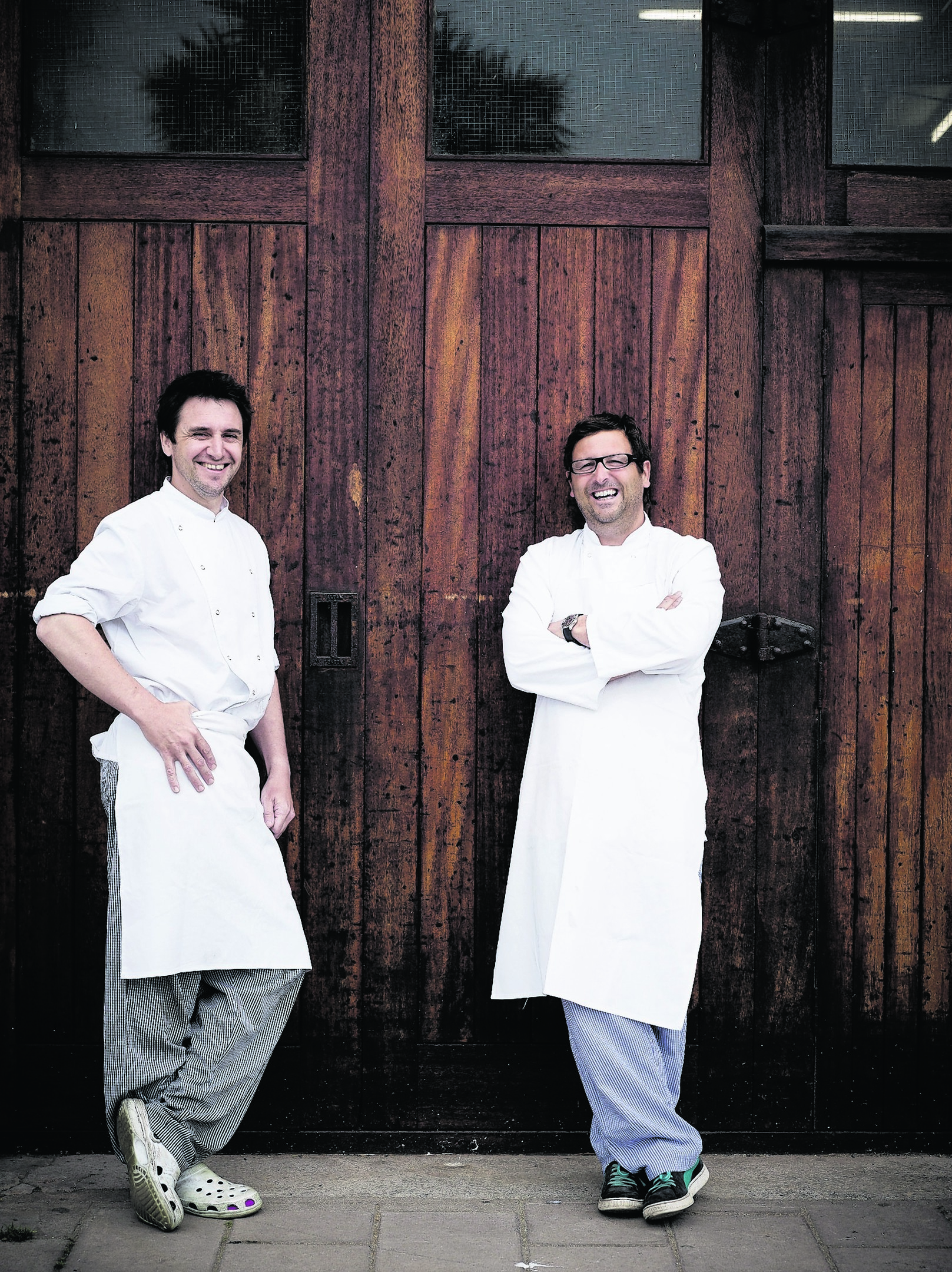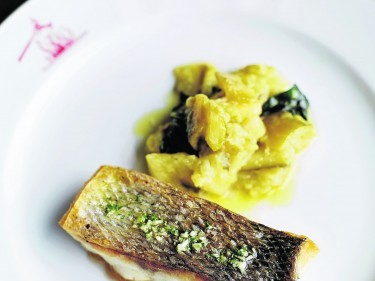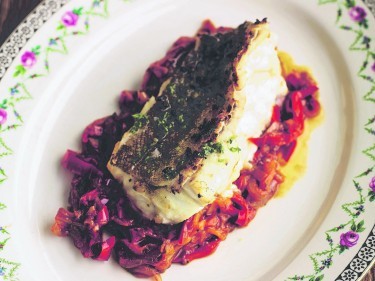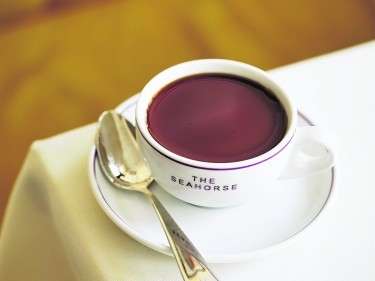Forget coffee, tea or an icy shower, if there’s anything guaranteed to give restaurant owners Mitch Tonks and Mat Prowse a boost in the morning, it’s their breakfast grappa.
Since travelling around Europe years ago, on the hunt for culinary inspiration for their celebrated Seahorse restaurant in Devon, the two friends have continued the boozy ritual, which is popular in food markets in Italy and Spain.
“The secret is, it’s only one drink,” says award-winning chef Tonks, who fronted Good Food series, Mitch and Matt’s Big Fish Recipes, with former rugby star Matt Dawson.
The pair’s customary drink is part and parcel of the atmosphere they create in the restaurant, with dancing on tables and musical interludes from their maitre d’ Mark Ely encouraged.
Tonks and Prowse have just released a new recipe book (The Seahorse, Absolute Press, £25) based on the dishes they serve in their restaurant.
“Everything you hear about fish, whether it’s sustainability or cooking it, is all negative,” says Prowse. “But it’s not. It’s easy to cook. Very simply with the sustainability thing, just find yourself a good fishmonger and trust they’re doing that bit for you.”
Fancy trying your hand at some simple fishy dishes? Here are three recipes from the book.
SEA BASS WITH BRAISED COURGETTES
SERVES 4
100ml plus 1tbsp olive oil
2 garlic cloves, finely chopped
4 courgettes, cut into quarters then cut into 2.5cm chunks
A good handful of basil, roughly torn
4 sea bass fillets, about 180-200g each, skin on
1 lemon
Salt and ground white pepper
1 lemon, cut into wedges, to serve
Preheat the oven to 200C/Gas 6.
Heat the 100ml of olive oil in a saucepan over a medium heat. Add the garlic and sweat for a minute without colouring. Next, add the courgettes and basil, then season with salt and white pepper and mix well. Cook the courgettes for about 15 minutes, stirring regularly until most of the water from the courgettes has evaporated and they have stewed down, leaving some in chunks and some completely broken down. Take off the heat and set aside.
Heat a large ovenproof frying pan with the tablespoon of olive oil over a medium heat. Place the sea bass in the pan skin-side down, season with a little salt and cook for about 12 minutes until the sea bass skin starts to take some colour and begins to crisp.
Carefully turn the fillets over and place the pan into the oven and roast for about five minutes, or until the flesh turns white and flakes easily.
To serve, reheat the courgettes over a low heat until they are just warm. Add a good squeeze of lemon and put a generous spoonful onto each warmed plate. Put the sea bass on top and serve with a lemon wedge.
RED GURNARD WITH PEPERONATA AND SALSA VERDE
SERVES 4
50ml olive oil
4 red gurnard fillets, about 180-200g each, skin on
FOR THE PEPERONATA:
50ml olive oil
2 red onions, sliced
2 garlic cloves, finely chopped
1tsp dried oregano
1tbsp tomato puree
1/2tsp ground cumin
2 red peppers, deseeded and sliced
2 yellow peppers, deseeded and sliced
A pinch of saffron strands
FOR THE SALSA VERDE:
A handful of flat-leaf parsley
A handful of basil
A handful of mint
2 garlic cloves
1tbsp capers
1tbsp red wine vinegar
12 salted anchovy fillets
1tsp Dijon mustard
4tbsp olive oil
Salt
For the pepperonata, heat the olive oil in a lidded saucepan over a medium heat. Add the onions, garlic and oregano and sweat for five minutes, or until soft. Add the tomato puree and cumin and cook for a further two minutes. Next, add the peppers and saffron and mix well, then cover the pan with a lid and stew the peppers for 20 minutes, stirring occasionally.
Uncover and cook for a further 10 minutes, stirring occasionally. Check the seasoning then remove from the heat.
Preheat the oven to 200C/Gas 6. To make the salsa verde, place all the ingredients except the olive oil into a food processor and pulse-blend them to a rough paste. Add half the oil and blend again to combine, then add the remaining oil and repeat.
To cook the fish, heat the olive oil in a large, ovenproof frying pan over a medium heat. Add the red gurnard and cook for about two minutes until golden on one side.
Carefully turn the red gurnard over and place the pan into the oven and roast for six to eight minutes (depending on size and thickness of fish) until cooked.
Remove the fish from the oven and serve with a spoonful of the peperonata and the salsa verde.
CARAMEL AND ESPRESSO PANNACOTTA
MAKES 12 ESPRESSO CUPS
FOR THE PANNACOTTA:
4 gelatine leaves
220ml freshly made espresso
220ml full-fat milk
120g caster sugar
100ml brandy
360ml double cream
FOR THE SYRUP:
100ml water
300g granulated sugar
125ml freshly made espresso
25ml brandy
Place the gelatine in a small bowl and pour over enough cold water to cover. Soak for five minutes, or until soft, then drain and squeeze out the excess water.
To make the pannacotta, warm the espresso, milk and sugar in a saucepan over a low heat, stirring occasionally until the sugar has dissolved. Add the softened gelatine and stir to dissolve in the warm liquid. Take off the heat and allow to cool (not completely cold, just tepid). Add the brandy and cream and mix well until combined, then pour into espresso cups and allow to set for at least four hours in the fridge.
For the syrup, make a caramel: pour the water into a deep heavy-based saucepan, add the sugar, stir and put over a gentle heat to dissolve the sugar; keep stirring until it is fully dissolved. Once the sugar has dissolved, bring to the boil, and boil until the syrup is a light golden colour. Take off the heat and allow to cool slightly, but not get completely cold.
Carefully pour the 125ml of espresso into the cooled syrup and stir until smooth, then add the brandy. Stir to combine and allow to cool.
To serve, pour a little of the syrup over the top of the pannacottas to completely cover the surface.



